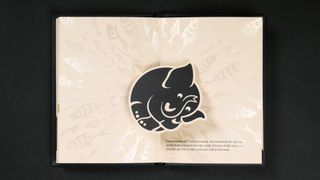BKWLD
Oliver Lindberg talks to Ryan Vanni, Dan Fields, Robert Reinhard and Jeff Toll of BKWLD about the agency’s fresh approach to interactive design and the science of a good banner ad
.net: What does BKWLD stand for?
RV: In 2000, when my then-bandmate and I talked about starting a company, his first idea for a name was “Bukwild”. We both immediately lit up. To us, being rebellious 20-year-olds, Bukwild meant no rules. And if there were any, they were ours: we were going to do it our way. However, after a couple of years in business, and countless “What are you guys, a porn shop?” jokes, our then creative director Scott Hansen (now ISO50) had the brilliant idea of taking out the vowels to create a fictitious acronym. I thought maybe we’d make up some last names to put on the door – Berkowitz, Klein, Woods & Davis. Ironically, now that we have close to a decade under our belts, I’m growing less and less concerned with ‘being taken seriously’ via our name. It’s our name, damn it; if it’s too bad'rap'rock-song for you, go fly a kite…
.net: What do you specialise in?
DF: BKWLD's specialities include banner ads, retail websites and powerful content management systems. As far as technologies go, our bread and butter are Flash AS3 and PHP/MySQL.
.net: You collaborate quite a bit with other agencies. How does that work for you?
DF: Working with an agency, you end up technically having to appease two clients – the agency and the client – so some projects go through quite a few more rounds or have more work than a direct'to'client project. Thankfully, we’re in a situation where we’ve earned a voice with many of our traditional agency clients, where they look to us as interactive experts, not as a “Here’s a PSD, shut up and build it” agency.
.net: You meddle a fair bit in games, too. What makes a successful online game?
DF: Most of the games we’ve been hired to create are part of an effort to move traffic to a site virally. As a result, they’re designed to be simple to pick up but very addictive. To me, there are four things that make an online game successful. One is competition, whether it’s to get your name at the top of the scoreboard or brag to a friend on Facebook that you just did something on FarmVille. Another is to keep the game variable, so that it stays fresh and different. For example, there are random icons you can collect, for good or for bad effects, so the game is different on every play. Another big one is to offer an incentive. If people are playing for an iPod/gift certificate/hamburger, then they’re much more likely to keep trying than if they’re playing just for fun. And finally, the game had better be easy to pick up and learn. If you need more than one page of instructions, it’s going to be too complicated for a casual gamer and not complicated enough for a hardcore gamer.
.net: How did you get to work in the entertainment industry?
DF: It all started with Ryan wanting to make websites for bands, opening a phone book and calling every record agency listed until we finally got a project for J Records. From there, we aligned ourselves with more and more musicians and labels, because if there’s a ‘who you know’ industry, it’s certainly the music industry.
.net: You still do banners. Aren’t they old-school?
DF: There are plenty of terrible banners out there, placed on the wrong sites, with zero calls to action and no incentive. Thankfully, that’s all changing. Placing the correct ad in front of the correct consumer is getting more scientific and thought-out. Also, site takeovers and other experiences, such as the ones we’ve created for Domino’s and Columbia, make the impressions worth just as much as the click-throughs. We’re in essence creating mini-sites in these banners, enabling users to experience our ad without leaving the site.
There are plenty of terrible banners out there, placed on the wrong sites, with zero calls to action and no incentive. Thankfully, that’s all changing.
.net: How do you keep up to date with the latest tools and techniques?
RR: As a company, we’re making more of an effort this year to attend events and conferences. I don’t think a person picks up detailed skills there, but they give you time to think about the big picture and introduce you to new approaches. Besides this, we just rely on the internet: RSS feeds, Google searches and blogs. Stackoverflow (stackoverflow.com) has developed into a great resource.
.net: How do you test your sites/games/apps?
RR: We use Litmus to test HTML build in multiple browsers. We lead development largely on Macs but we have some PCs and we run VMware to test interactivity cross-OS.
.net: What are you currently working on?
DF: In 2010 we’re looking forward to continuing our relationships with some of the biggest and best agencies in the world, like Crispin, Porter + Bogusky, Goodby, Silverstein & Partners and Butler, Shine & Stern, as well as maintaining our direct client relationships with Burton (Gravis/Analog), Gregory Mountain Products, Dragon and others. We’re also launching some fun projects for Bing (Catalysis), Getty Images and Chobani Yogurt (TDA).
.net: What’s the most bizarre request you’ve had?
JT: The bizarre requests come from our eccentric music clients. It’s not unheard of to be asked to design the client taking a bubble bath with their dogs; a talking dolphin wearing a headset named bubbles; or an illustration of a penis with glimpses of Richard Simmons.

Thank you for reading 5 articles this month* Join now for unlimited access
Enjoy your first month for just £1 / $1 / €1
*Read 5 free articles per month without a subscription

Join now for unlimited access
Try first month for just £1 / $1 / €1
Get the Creative Bloq Newsletter
Daily design news, reviews, how-tos and more, as picked by the editors.
The Creative Bloq team is made up of a group of design fans, and has changed and evolved since Creative Bloq began back in 2012. The current website team consists of eight full-time members of staff: Editor Georgia Coggan, Deputy Editor Rosie Hilder, Ecommerce Editor Beren Neale, Senior News Editor Daniel Piper, Editor, Digital Art and 3D Ian Dean, Tech Reviews Editor Erlingur Einarsson and Ecommerce Writer Beth Nicholls and Staff Writer Natalie Fear, as well as a roster of freelancers from around the world. The 3D World and ImagineFX magazine teams also pitch in, ensuring that content from 3D World and ImagineFX is represented on Creative Bloq.




